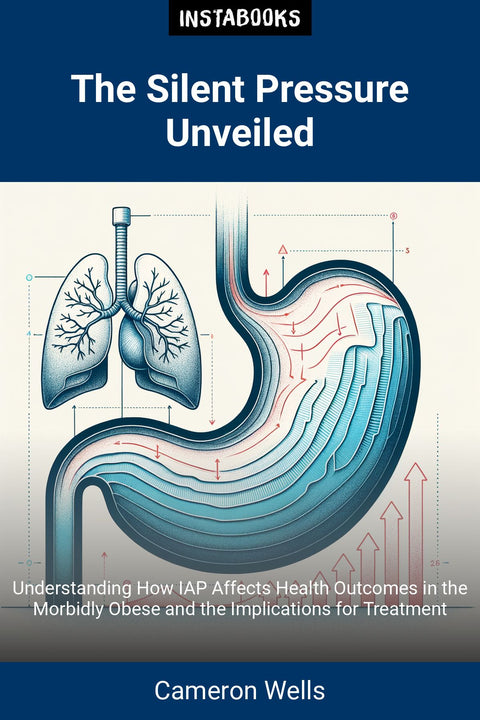
Cameron Wells (AI Author)
The Silent Pressure Unveiled
Premium AI Book (PDF/ePub) - 200+ pages
Introduction to Intra-Abdominal Pressure
In the realm of medical research, few subjects are as critical and often overlooked as the relationship between intra-abdominal pressure (IAP) and the morbidity faced by morbidly obese patients. As the prevalence of obesity continues to rise globally, understanding the underlying mechanisms that affect health outcomes has never been more essential. This book delves into the intricate relationship between elevated IAP and various health complications, revealing how significant even seemingly minor fluctuations in pressure can be.
Understanding Elevated IAP
Recent studies have shown a concerning trend: morbidly obese patients often experience significantly higher levels of IAP compared to healthy individuals. Through extensive research involving patients with a body mass index of over 35 kg/m², this book presents compelling findings, including the fact that the mean IAP in these patients frequently surpasses recommended thresholds. But what does this mean for their overall health?
Correlation with Central Obesity
One of the key areas of exploration in this book is the strong correlation between IAP and central obesity. The evidence suggests that as visceral fat increases, so too does IAP. Unlike conventional measures such as BMI, IAP provides a more nuanced understanding of how body fat distribution influences health outcomes. Readers will learn about how this correlation can lead to a range of obesity-related health issues.
Health Complications Associated with High IAP
Elevated IAP is linked with several severe health complications, including gastroesophageal reflux disease, stress incontinence, and even diabetes. Through case studies and recent research, this book highlights how these conditions are aggravated by elevated IAP, illustrating a direct relationship that must be addressed in treatment plans for morbidly obese patients.
The Distinction Between Elevated IAP and Abdominal Compartment Syndrome
While the risks posed by elevated IAP are significant, understanding the difference between elevated IAP and abdominal compartment syndrome (ACS) is crucial. This book clarifies that while increased pressures are indeed alarming, they do not always indicate the acute condition of ACS, thus guiding healthcare providers in their management strategies.
Moving Toward Better Patient Outcomes
The insights offered in this book are not merely academic; they hold the potential for real-world application. Armed with a better understanding of IAP's impact on health, healthcare professionals can make wiser decisions that enhance patient outcomes. Monitoring IAP can serve as a proactive measure in preventing complications for morbidly obese individuals, ultimately improving their quality of life.
Table of Contents
1. Understanding Intra-Abdominal Pressure- What is IAP?
- Measurement Techniques for IAP
- Significance of Monitoring IAP
2. Elevated IAP in Obesity
- The Science Behind Elevated IAP
- Impact of Visceral Fat on IAP
- Clinical Examples of Elevated IAP
3. Correlation with Central Obesity
- Defining Central Obesity
- IAP vs. BMI: A Comparative Study
- Role of Sagittal Abdominal Diameter
4. Health Complications Linked to High IAP
- Gastroesophageal Reflux Disease
- Hernias and Stress Incontinence
- Diabetes and Hypertension Connections
5. Abdominal Compartment Syndrome vs. Elevated IAP
- Distinguishing ACS from Normal IAP Increase
- Clinical Thresholds and Significance
- Management Implications for Clinicians
6. Case Studies and Research Findings
- Recent Studies on IAP in Morbidly Obese Patients
- Intervention Strategies Learned from Case Studies
- Implications for Future Research
7. Practical Applications in Patient Care
- Routine IAP Monitoring
- Integrating IAP Insights into Treatment Plans
- Patient Education and Awareness
8. Nutritional Factors and IAP
- Dietary Impacts on Intra-Abdominal Pressure
- Weight Loss and Its Effects on IAP
- Nutritional Recommendations for Morbidly Obese Patients
9. Physical Activity and IAP Levels
- Exercise Benefits for Morbid Obesity
- Activities to Lower IAP
- Barriers to Physical Activity
10. Psychosocial Considerations
- Mental Health and Morbid Obesity
- The Role of Support Systems
- Addressing Psychological Barriers to Treatment
11. Emerging Research Directions
- Future Trends in IAP Research
- Technological Advances in Measurement
- Policy Implications and Healthcare Systems
12. Improving Patient Outcomes through Understanding IAP
- Summary of Key Findings
- Implementing Changes in Clinical Practice
- Encouraging Patient Engagement and Empowerment
Target Audience
This book is written for healthcare professionals, researchers, and students interested in understanding the complexities of intra-abdominal pressure and its impact on the health of morbidly obese individuals.
Key Takeaways
- Understanding the significance of IAP in morbidity among the morbidly obese.
- Identifying correlations between central obesity and elevated IAP.
- Recognizing health complications that arise from high IAP.
- Distinguishing between elevated IAP and abdominal compartment syndrome.
- Implementing monitoring strategies to improve patient outcomes.
How This Book Was Generated
This book is the result of our advanced AI text generator, meticulously crafted to deliver not just information but meaningful insights. By leveraging our AI book generator, cutting-edge models, and real-time research, we ensure each page reflects the most current and reliable knowledge. Our AI processes vast data with unmatched precision, producing over 200 pages of coherent, authoritative content. This isn’t just a collection of facts—it’s a thoughtfully crafted narrative, shaped by our technology, that engages the mind and resonates with the reader, offering a deep, trustworthy exploration of the subject.
Satisfaction Guaranteed: Try It Risk-Free
We invite you to try it out for yourself, backed by our no-questions-asked money-back guarantee. If you're not completely satisfied, we'll refund your purchase—no strings attached.
